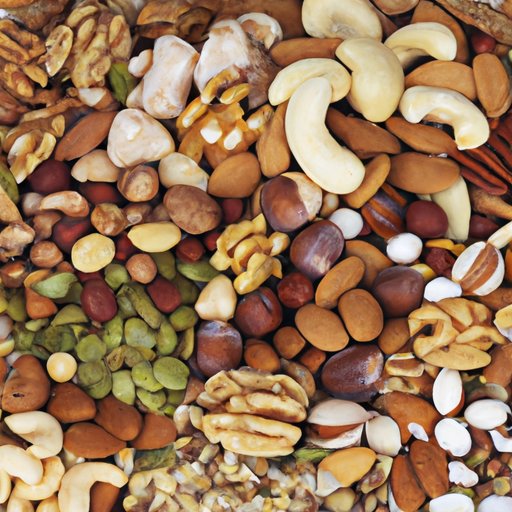Introduction
Protein is an essential nutrient that helps build and repair muscle and tissue, and it also plays an important role in many other bodily functions. It’s important to get enough protein in your diet, and nuts are a great source of this nutrient. But which nuts have the most protein? This article will explore the different types of nuts and their protein content to help you find the best sources of high-protein nuts.

A Comparison of Protein Content in Different Nuts
Almonds are one of the most popular types of nuts and they’re also one of the highest in protein. One ounce of almonds (about 23 almonds) contains 6 grams of protein. Walnuts are another type of nut that’s high in protein with 4 grams per ounce (14 halves). Pecans contain 3 grams of protein per ounce (19 halves). Pistachios have 6 grams of protein per ounce (49 kernels). Cashews have 5 grams of protein per ounce (18 kernels). Finally, macadamia nuts have 2 grams of protein per ounce (10-12 nuts).
How Much Protein Do Nuts Contain?
The average protein content of different types of nuts varies, but there can be quite a range between different brands of nuts as well. While some brands may contain more protein than others, the difference may not be significant. It’s important to read the nutrition label of each brand of nut to determine the exact amount of protein per serving.
Nuts with the Highest Protein Content
When it comes to nuts with the highest protein content, almonds, walnuts, and cashews top the list. Almonds are the highest in protein with 6 grams per ounce, followed by walnuts with 4 grams per ounce, and cashews with 5 grams per ounce. These three types of nuts are a great way to get a good dose of protein in your diet.

Eating Nuts to Reach Your Protein Goals
In order to reach your daily protein goals, it’s important to understand the recommended serving size for nuts. The general recommendation is to eat 1.5 ounces of nuts per day, which is about 30 almonds, 28 walnut halves, 20 pecans, 14 cashews, or 10 macadamias. You can also combine nuts with other high-protein foods like lean meats, eggs, and dairy products to reach your daily protein goals.
Nutritional Benefits of High Protein Nuts
In addition to being a great source of protein, high-protein nuts also offer a variety of other nutritional benefits. They are rich in vitamins and minerals such as vitamin E, magnesium, and zinc. They are also a good source of healthy fats, including monounsaturated and polyunsaturated fatty acids. Finally, they also contain dietary fiber, which is important for digestion and overall health.

What to Look for When Buying High Protein Nuts
When shopping for high-protein nuts, it’s important to look for organic varieties whenever possible. Organic nuts are grown without the use of pesticides and other chemicals. It’s also important to look for unsalted varieties to avoid added sodium. Lastly, look for raw or roasted varieties for added flavor, texture, and crunch.
Recipes Featuring High Protein Nuts
Once you’ve found the perfect high-protein nuts, you can start experimenting with different recipes. Protein bars are a great way to get a quick boost of protein. Salads are another great way to incorporate nuts into your diet. And smoothies are a delicious way to add nuts to your breakfast routine. There are endless possibilities when it comes to incorporating high-protein nuts into your diet.
Conclusion
Nuts are a great source of protein and they offer a variety of other nutritional benefits as well. Almonds, walnuts, and cashews are the highest in protein, and they should be included in your daily diet. Be sure to look for organic, unsalted, and raw or roasted varieties for maximum nutrition. And don’t forget to experiment with recipes featuring high-protein nuts for a nutritious and delicious meal or snack.


